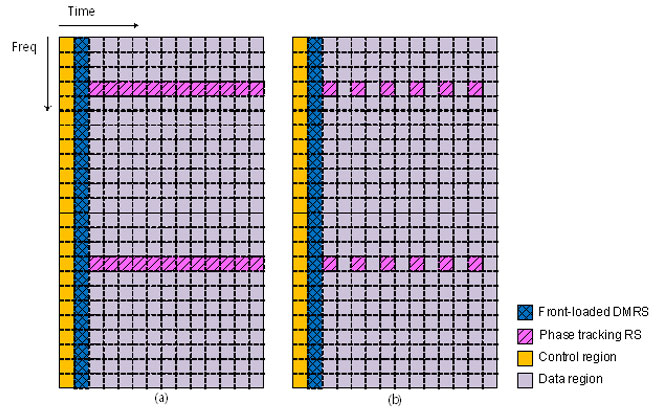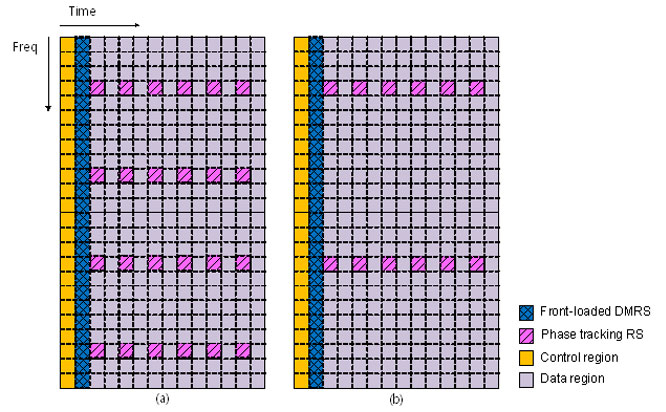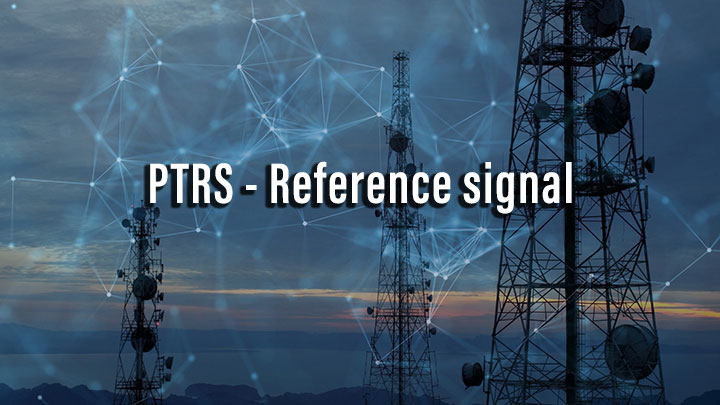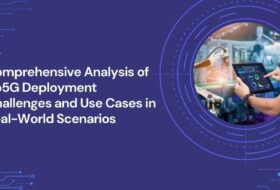Phase Tracking Reference Signal (PTRS)
PT-RS use is mainly to estimate and minimize the effect of CPE on system performance. Due to the phase noise properties, PT-RS signal has a low density in the frequency domain and a high density in the time domain. PT-RS always occurs in combination with DM-RS and only when the network has configured PT-RS to be present.
Why PTRS Reference signal Required
- Phase noise, caused by oscillator implementation technology destroys the orthogonality of subcarriers in OFDM.
- This causes common phase error (CPE), causing a constant rotation angle of the modulation constellation, and inter-carrier interference (ICI), and causing scattering of the constellation points in OFDM based systems.
- Limits the maximum received SNR especially at higher carrier frequencies. The PN impact may be handled by using large subcarrier spacing and PN estimation and compensation at the receiver.
- One of the use cases of NTN(non-terrestrial network) could be that airborne/space borne vehicles might act as a relay and connected to the ground node via wireless backhaul using mm Wave. It could also be envisioned to use Ka band (26.5 – 40.0 GHz) where for higher frequency use case scenarios, PTRS design issues might become important. Due to extreme long distance between the transmitter and the receiver, modulation order tends to remain low. In this case, PTRS might even be not needed. But for eMBB over NTN, modulation order might not be low. Considering the speed of LEO satellites, CFO and Doppler might be worse in NTN and hence PTRS might become useful in those scenarios
RS patterns for phase tracking :

Time-domain density PTRS
- The phase tracking RSs for the phase noise estimation (more specifically, common phase noise) can be continuously allocated along with the time domain as seen in Figure above.
- This time continuous additional RS allocation is to reflect the low-correlation characteristics of common phase errors among the consecutive OFDM symbols.
- If an outdated phase estimate is used for phase compensation, the performance of the phase compensation will be degraded. Hence, it is desirable to perform phase noise estimation at least once per OFDM symbol. However, this continuous phase tracking RS configuration can consume a significant portion of time-frequency resources.
- Hence, we can consider a less dense phase tracking RS pattern in order to improve resource usage efficiency while somewhat sacrificing phase tracking accuracy, as seen in Figure.

Frequency-domain density
- Frequency-domain phase tracking RS density is also a design parameter.
- At a specific OFDM symbol, the common phase error estimation involves in combining multiple RSs distributed in the frequency domain.
- In this situation, estimating with more samples will enhance the phase tracking accuracy while consuming more resources. In this regard, an effort is required to select a suitable frequency domain phase tracking RS density. Figure above shows two high and low frequency-domain densities of the phase tracking RSs.
PTRS is configured for High-Band.
For PTRS associated with PDSCH, the following applies:
- UE-specific reference signal
- Compensates phase noise effects
- Present only if transmitted together with a PDSCH or DMRS
- One PTRS is transmitted every symbol, every second symbol, or every fourth symbol (time densities are 1, ½, or ¼)
- One PTRS is transmitted every 12th, every 24th, or every 48th subcarrier (frequency densities are 1, ½, or ¼ each resource block)
- PTRS mapping starts at the first symbol that contains PDSCH in the slot. Then it is mapped to every L symbol, based on time density 1/L. PTRS is not transmitted in OFDM symbols that contain a CORESET or a PDSCH DMRS.
- PTRS mapping restarts at each DMRS symbol, and is then mapped relative to this symbol. In two adjacent DMRS symbols, mapping restarts using the second DMRS symbol as the reference.







